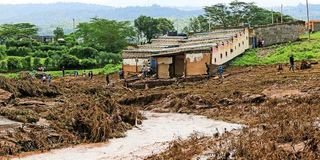Breathe, Nairobians, flooding will soon ease. Coast, brace for heavy rains

Water flows past ruins of houses destroyed by water after heavy flash floods wiped out several homes when a dam burst, following heavy rains in Kamuchiri village of Mai Mahiu, Nakuru County, Kenya April 29, 2024.
What you need to know:
- Sporadic rainfall and storms are also expected in the North-western Region.
- The anticipated increase in rainfall, the weatherman says, is expected to have various impacts on different sectors
Kenyans can expect near-average to above-average rainfall with occasional storms in May, according to the Kenya Meteorological Department (KMD). This comes as many areas are already dealing with disruptive heavy rains and flooding.
The forecast highlights that April marked the peak of the long rains (March-April-May) season over most pockets of the country except the Coastal and Western regions where the peak is expected this month.
“Going by the models that we are using to make the forecast, that is also one of the places where we expect the season to cease in mid-June,” says KMD Director David Gikungu.
For the next three months, rainfall is expected over the Highlands West of the Rift Valley, the Lake Victoria Basin, Central and South Rift Valley, as well as the Coastal strip, including Mombasa, Kilifi, Lamu, Kwale and Parts of Tana River.
The Highlands East of the Rift Valley, including Nairobi County, and parts of the Southeastern lowlands, are likely to experience rainfall in May, with occasional light rains in June and July. The rest of the country is expected to receive occasional rainfall in May and remain generally dry in June and July.
Dr Gikungu also said that the entire country will experience temperatures that are warmer than normal between May and July, with high probability of warmer-than-average temperatures expected over the eastern half of the country.
In regions such as the Lake Victoria Basin (Siaya, Kisumu, Homa Bay, Migori, Busia, Highlands West of the Rift Valley (Bungoma, Kisii, Nyamira, Bomet, Nandi, Kakamega, Vihiga, West Pokot, Elgeyo Marakwet, Trans Nzoia and Uasin Gishu), Central and South Rift Valley (Baringo, Nakuru, Narok and Western parts of Laikipia County) rainfall is expected throughout the month. The total amounts of rainfall are likely to be above average. Occasional storms are also likely to be experienced.
Sporadic rainfall and storms are also expected in the North-western Region (Turkana and Samburu).
“Highlands East of the Rift Valley including Nairobi County (Nairobi, Nyandarua, Nyeri, Kirinyaga, Murang'a, Kiambu, Meru, Embu, Tharaka-Nithi and eastern parts of Laikipia), it is likely that the regions will experience intense rainfall in the first week of May. The total amounts of rainfall are likely to be above average and these pockets of the country will also have periodic storms,” he offers.
The anticipated increase in rainfall, the weatherman says, is expected to have various impacts on different sectors. In terms of agriculture and food security, the expected rainfall is likely to be conducive for agricultural production, especially in high-potential counties such as the Highlands West of the Rift Valley, the Lake Victoria basin region, and Central and Southern Rift Valley. In arid and semi-arid areas, the rainfall is expected to improve pasture and browse, benefiting pastoralists and their livestock.
“There is a likelihood of flooding in low-lying areas, flood plains, and poorly drained urban centres, especially in the Lake Victoria Basin, the Highlands West of the Rift Valley, and the Coastal region. Lightning strikes are also expected in certain areas, and precautions should be taken to avoid the risk of lightning-related accidents.
While this is expected to have positive impacts on agriculture, water resources, and tree growth, the weatherman also raises concerns about potential disasters.





